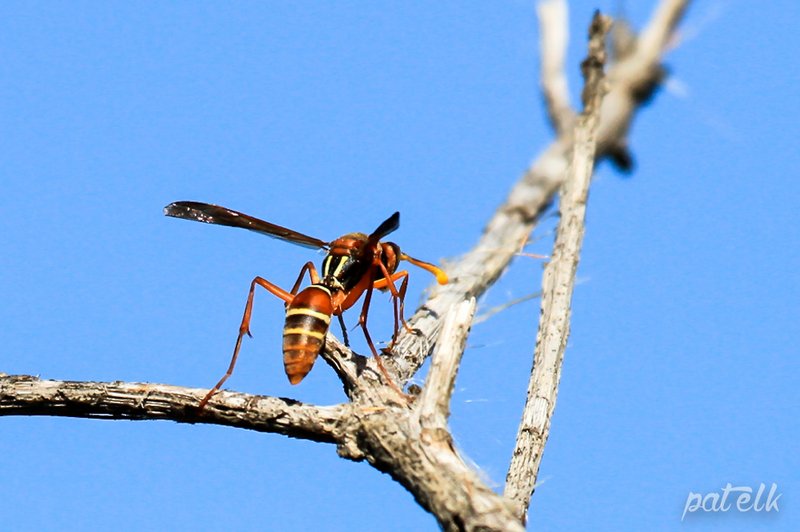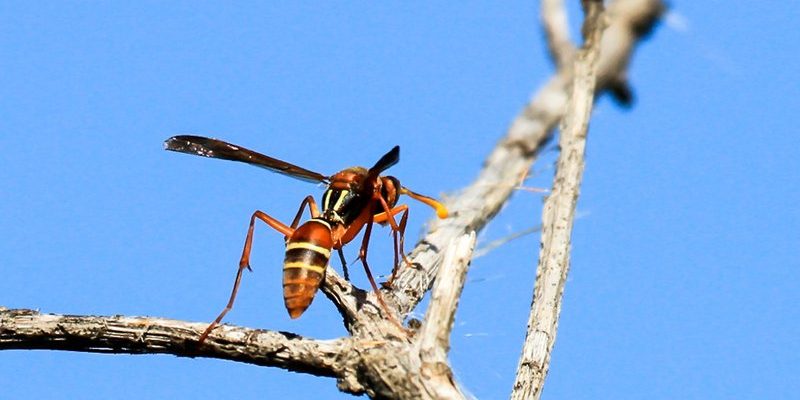
In this article, we’re diving deep into the world of paper wasps. We’ll explore ten fascinating facts that highlight their unique behaviors, habitats, and more. Don’t worry if you’re a beginner when it comes to bugs—I’ll break everything down for you in a way that’s easy to understand.
1. What Are Paper Wasps?
Paper wasps belong to the family Vespidae, which includes other wasps like yellow jackets and hornets. Unlike those aggressive yellow jackets, paper wasps are generally more docile and less likely to sting unless provoked. These fascinating creatures are known for their ability to create nests from chewed wood fibers mixed with their saliva, making their homes look like architectural wonders. Picture a small, umbrella-shaped structure hanging from a tree branch—a perfect little fortress!
Most paper wasps are slender and long-legged, measuring about half an inch to one inch in length. Their coloration typically includes shades of yellow, brown, or black, giving them a striking appearance. They make up for their delicate looks with strong, crafty behaviors. You might even find them in gardens, where they play an essential role in pollination.
2. Unique Nest Building
One of the most impressive things about paper wasps is how they create their nests. They gather wood fibers from dead trees and other sources, then chew them into a paste. This paste is molded into thin, papery walls that form the shape of their nests. Isn’t that an incredible way to recycle?
Their nests are typically open and resemble a honeycomb, with hexagonal cells inside. Each cell is used to house a single egg. The nests can hold dozens of cells, allowing the wasps to raise plenty of young. Here’s the thing: these nests can be found hanging from eaves, trees, or shrubs—sometimes in the most unexpected places. So, if you spot one, be cautious!
3. Social Structure
Paper wasps are social insects, which means they live in colonies. However, their colonies are usually smaller than those of honeybees or yellow jackets. Most colonies consist of about 20 to 30 wasps. They have a clear social structure, with a queen at the top. When you think of a queen bee, picture a similar idea here—she’s the one who lays the eggs and keeps the colony going.
The worker wasps, which are usually female, take care of the nest, forage for food, and protect their home. Interestingly, these workers are often the daughters of the queen. This family setup leads to close cooperation among the wasps, and they communicate with each other through various sounds and pheromones.
4. Diet and Feeding Habits
You might be surprised to learn that paper wasps are not just meat-eaters. They have an interesting and varied diet. While they do enjoy protein from insects like caterpillars and flies to feed their larvae, they also crave sugary substances. You can often find them sipping nectar from flowers or even raiding picnic tables for sugary drinks.
This dual diet helps them play a crucial role in their ecosystems. By pollinating plants and controlling pest populations, paper wasps contribute to a healthier environment. So, the next time one buzzes around your soda, remember they’re not just being rude—they’re trying to refill on some much-needed energy!
5. Lifespan of Paper Wasps
When you think of insects, you might assume they have short lives. For paper wasps, that’s partly true. The lifespan of a paper wasp varies, but workers typically live for about 12 to 22 days. Interestingly, the queen can live up to a year, especially if conditions are favorable.
In the spring, the newly-mated queen emerges from hibernation to start a new colony. She builds the nest from scratch, lays her first batch of eggs, and nurtures her young into adulthood. Once the workers are mature, they take over the hard work, allowing the queen to focus on reproduction. It’s a delicate balance of life and responsibility!
6. They Can Sting, but Not Often
If you’ve ever been stung by a wasp, you know it can be painful. Paper wasps, like other wasps, do have stingers. However, they’re usually pretty chill and won’t sting you unless threatened. Think of them as the introverts of the insect world; they’d rather avoid conflict than engage.
If you accidentally disturb their nest, that’s when they might get defensive. It’s best to admire these creatures from a distance, especially if you see a nest hanging close by. If you’re ever in a situation where you’re approached by one, simply stay calm and walk away slowly. Panic will only agitate them!
7. Role in Ecosystems
Paper wasps play a critical role in their ecosystems, serving as natural pest controllers. By feeding on caterpillars and other insects, they help keep those populations in check. This is particularly important in gardens and agricultural areas, where crop damage from pests can be a huge concern.
Additionally, their pollination activities contribute to plant reproduction. You might not think of wasps as pollinators, but they certainly help many flowering plants thrive. So, the next time you see a paper wasp buzzing around, remember they’re doing some serious work behind the scenes!
8. Mating and Reproduction
The mating process for paper wasps is unique and quite fascinating. In late summer or early fall, a few male wasps will emerge from the nest to mate with the queens from other nests. Once mating occurs, the males die shortly after. Meanwhile, the fertilized queens find a safe spot to hibernate until spring, when they will start the cycle all over again by establishing new colonies.
The queens are the only ones to survive the winter, while the rest of the colony typically dies off. When spring arrives, these queens are ready to begin the whole process again, laying eggs and raising new worker wasps. This cycle is vital for maintaining their populations.
9. Common Misconceptions
A lot of people have misconceptions about paper wasps, and it’s time to clear the air. First, many think all wasps are aggressive. In reality, paper wasps are often more laid-back than their vibrant yellow jacket relatives. They might look intimidating, but they’re usually just minding their own business.
Another misconception is that they can damage gardens or homes. While they do build nests in various places, they typically don’t cause harm unless provoked. Understanding their behavior can help you coexist peacefully with these fascinating creatures.
10. How to Coexist with Paper Wasps
If you have a nest of paper wasps near your home, you might be wondering how to handle it. The best approach is to leave them alone, especially if they’re not causing any harm. Paper wasps are generally non-aggressive, and they can offer benefits by keeping your garden bug-free.
However, if you feel their nest poses a threat, it’s wise to contact a pest control expert. They can safely remove the nest without causing unnecessary harm to the wasps or the environment. Always remember, these insects are an important part of our ecosystem, so coexistence is often the best option!
In conclusion, paper wasps are much more than just buzzing annoyances. With their unique behaviors, ecological contributions, and specialized social structures, they’re fascinating creatures worthy of respect. Next time you spot one, I hope you’ll appreciate the busy little artist at work, crafting homes and preserving balance in nature.

